Effective vocabulary teaching goes beyond simply showing words, explaining meanings, and giving examples. Whether teaching children or adults, each group of learners requires a variety of strategies suitable for their needs in order to learn new words quickly and remember them for longer. So, how to teach vocabulary the right and effective way? This article offers practical insights and methods worth exploring.
1. How to Teach Vocabulary?
Before exploring the question “How to teach vocabulary?”, it is helpful to reflect on how children, and how we ourselves, once learned our first language.
Children learn to say “cat” because adults repeatedly point to a cat and say the word out loud. They learn to ask where something is by imitating adults. They do not acquire vocabulary through textbooks or by taking notes the way adults often do. Instead, they approach language in a simple, natural way.
In fact, much of the vocabulary we use in our native language today comes from those early, intuitive experiences. This fundamental approach can serve as a useful guide when designing vocabulary teaching methods.
The following are some effective strategies for teaching vocabulary that can be applied to both young learners and adults:
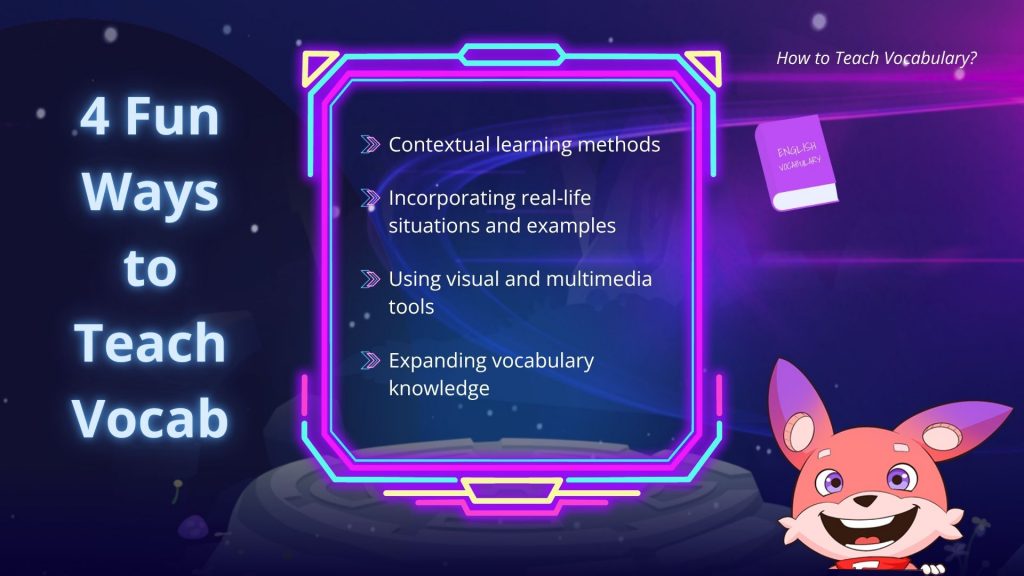
1.1. Contextual Learning Methods
Language is inherently used for real-life communication. Therefore, teaching vocabulary in context and encouraging immediate classroom application is one of the most effective methods to help learners absorb the language naturally and efficiently.
| What to do? | Example for Kids | Example for Adults |
|---|---|---|
| Teach vocabulary by topic. | – Food and drinks (apple, bread, milk) – School objects (pen, book, ruler) | – Jobs and workplaces (doctor, office, salary) – Health and body (headache, medicine, exercise) |
| Provide real-life context through dialogues, role-plays, or real-world materials such as menus, ads, or short articles. | Use a short dialogue between cartoon characters to introduce the phrases “What’s your name?” or “I like ice cream.” | Create a role-play where learners act out ordering food at a restaurant, using target vocabulary like “menu,” “starter,” and “bill.” |
| Encourage vocabulary use in sentences or short paragraphs. | Let learners draw a picture and write a simple sentence about the picture. | Ask learners to write a few sentences about their weekend plans with the words “relax,” “picnic,” or “visit.” |
1.2. Incorporating Real-Life Situations and Examples
If contextual learning methods simulate real-life situations in the classroom, then incorporating real-life situations and examples brings learning even closer to everyday life by using real people and authentic experiences as resources.
| What to do? | Example for Kids | Example for Adults |
|---|---|---|
| Incorporate real stories, personal experiences, or practical scenarios. | Tell a story about a trip to the zoo to introduce the words “elephant” or “cage.” | Share a short story about a business meeting to teach the words “agenda” or “deadline.” |
| Use authentic materials like news articles, advertisements, or job postings. | Use a supermarket flyer to teach words like “price” or “discount.” | Analyze a job advertisement to learn the terms “qualifications” or “responsibilities.” |
| Invite guest speakers or organize field trips related to the vocabulary topic. | Arrange a visit to a fire station to learn words such as “firefighter” or “hose.” | Invite a nutritionist to discuss healthy eating vocabulary. |

1.3. Using Visual and Multimedia Tools
Studies have shown that combining images or interactive elements with new words helps learners retain and recall vocabulary more effectively, especially in second language acquisition. Here are some practical ways teachers can apply this in the classroom.
| What to do? | Example for Kids | Example for Adults |
|---|---|---|
| Use flashcards, charts, and posters that display images alongside relevant vocabulary. | Use colorful animal flashcards with pictures to teach basic animal names. | Show flashcards with business terms and related images during a professional English session. |
| Utilize online resources such as videos, podcasts, or interactive games. | Play interactive vocabulary games on tablets that match words with pictures. | Assign a short podcast episode on travel vocabulary followed by a discussion. |
| Integrate technology like interactive whiteboards or language learning apps. | Using FLYER.us to help students practice thematic and Cambridge-level vocabulary in a fun and engaging way. | Use an interactive whiteboard to brainstorm synonyms and antonyms in a group activity. |
1.4. Expanding Vocabulary Knowledge
When teaching vocabulary, teachers often provide learners with the most basic information, including word meaning, pronunciation, and example sentences.
While this foundation is useful, it may not be enough for long-term retention or effective use in diverse communication contexts. For instance, learners might understand that “decision” means “a conclusion or resolution reached after consideration“, yet struggle to use it correctly in a sentence.
To address this, the following strategies can help learners improve their vocabulary use more effectively.
| What to do? | Example for Kids | Example for Adults |
|---|---|---|
| Introduce word roots, prefixes, and suffixes. | Show how “play” becomes “replay” with the prefix “re-.” | Teach the prefix “un-” to form opposites, e.g., “happy” → “unhappy.” |
| Include common collocations. | Teach phrases like “brush teeth” or “do homework.” | Explain “make a decision” vs. “take responsibility.” |
| Teach synonyms and antonyms. | Teach “big” and its antonym “small,” plus synonyms like “large.” | Pair “happy” with synonyms like “joyful” and antonyms like “sad.” |
However, this approach may lead to knowledge overload. To prevent this, teachers can use mind maps to link new vocabulary with related concepts.

2. 5 Effective Steps for Teaching Vocabulary
With the 4 suggested strategies in mind, how can teachers apply them effectively in the classroom? To support this process, the following 5 steps offer a clear guide to designing more creative and efficient vocabulary lesson plans.
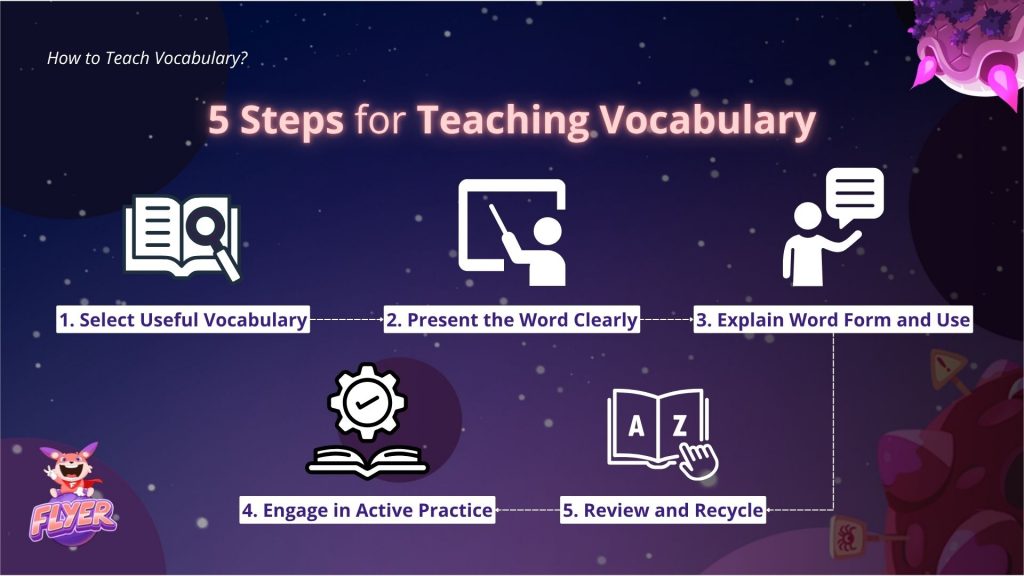
2.1. Step 1: Select Useful Vocabulary
Choose vocabulary that is relevant, frequent, and suitable for learners’ level and needs. For each word, it is important to cover related aspects such as:
- Meaning
- Word form (noun, verb, adjective, etc.)
- Pronunciation
- Spelling
- Grammatical features (e.g. uncountable noun, required prepositions)
- Connotations
- Appropriate usage in context
- Relationships with other words (synonyms, antonyms, lexical sets, etc.)
- Common collocations
- Word parts (prefixes, suffixes)
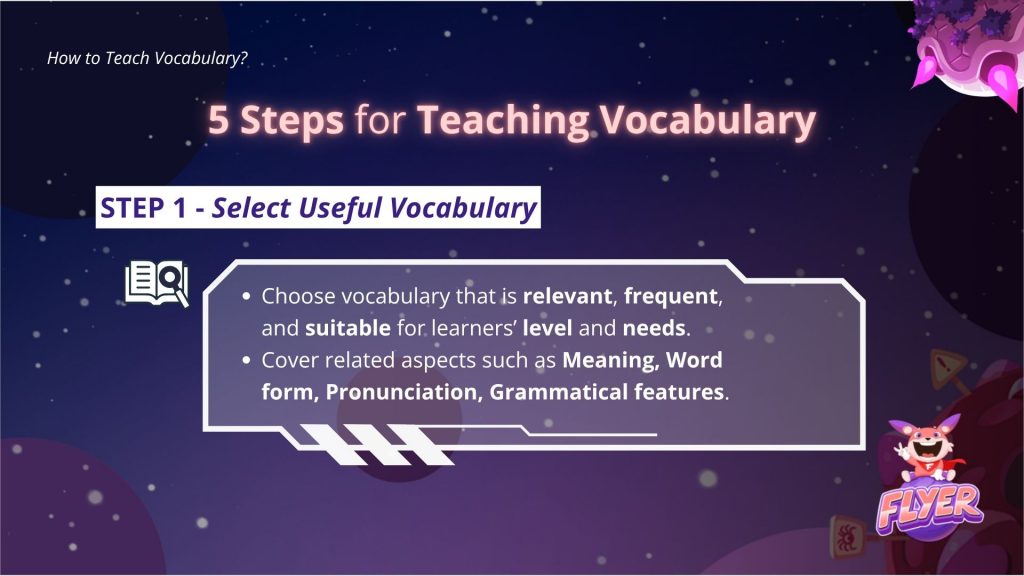
Depending on the learner’s age, proficiency level, and learning goals, these elements should be selected and organized appropriately when designing a vocabulary lesson.
For teachers following the Cambridge curriculum, FLYER provides a set of detailed, ready-to-use lesson plans aligned with Cambridge standards. These can serve as a valuable reference when planning vocabulary instruction.
Access the available lesson plans HERE.
2.2. Step 2: Present the Word Clearly
Preparing lesson plans with useful and level-appropriate vocabulary is just the first step. To ensure effective learning, how vocabulary is presented plays a key role. Below are some simple steps for presenting new words:
- Say the word clearly.
- Write the word on the board.
- Show the meaning using visuals, gestures, real objects, or simple definitions. Synonyms and antonyms can also help explain meaning. In some cases, translating the word into the learner’s first language may be necessary, but this method is not recommended and should be used only as a last resort.
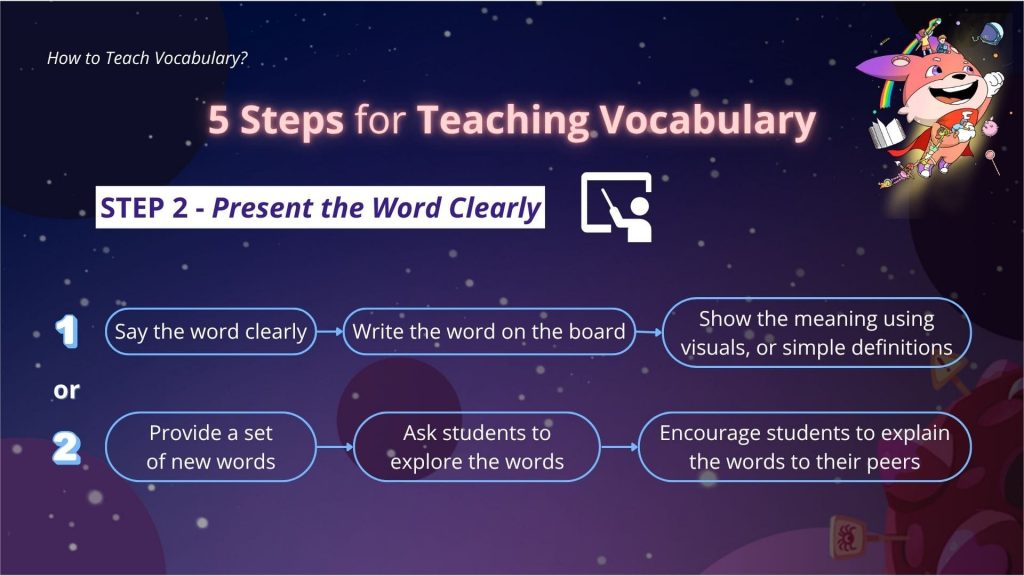
In addition to direct presentation, teachers can also encourage active learning by involving students in discovering word meanings themselves.
- Provide students with a set of new words.
- Ask them to explore the meanings, pronunciation, and create example sentences on their own.
- Encourage students to explain the words to their peers in groups.
2.3. Step 3: Explain Word Form and Use
This step supports learners in expanding their vocabulary knowledge. Teachers explain the related aspects prepared during lesson planning, such as pronunciation, collocations, and spelling.
It is also important to show how the word works in context through contextualized practice, for example, by giving example sentences or using short texts, dialogues, or stories that include the target word.

2.4. Step 4: Engage in Active Practice
Once students have mastered the target vocabulary, it is important to move on to practice activities to reinforce their understanding. Simple tasks at this stage may include:
- Using games, matching, gap-fill exercises, role plays, or story-making.
- Incorporating both receptive skills (listening, reading) and productive skills (speaking, writing).
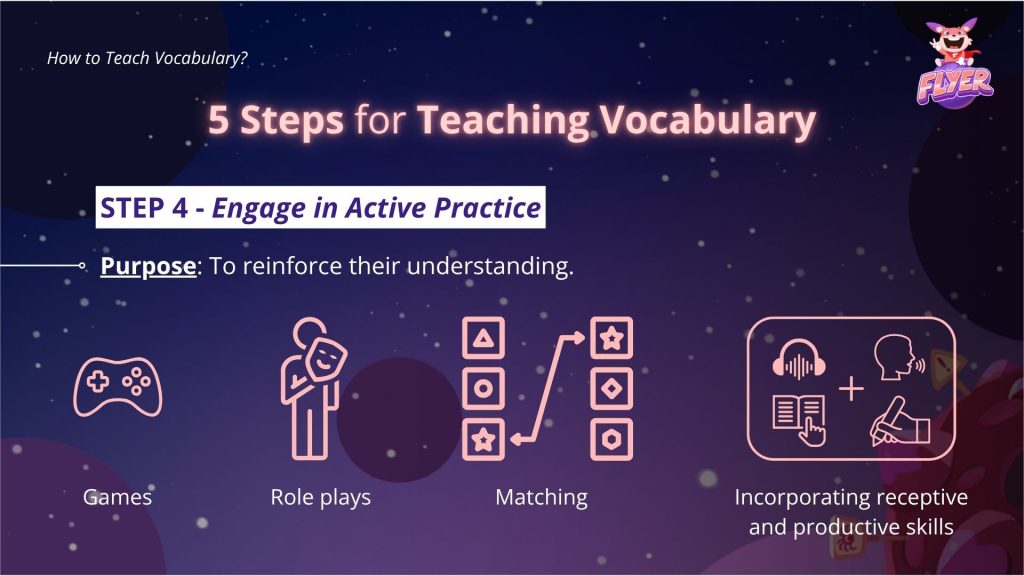
2.5. Step 5: Review and Recycle
Reviewing the new words can be done at the end of this lesson or at the beginning of the next. However, it is important to regularly revisit key vocabulary and integrate it naturally across different contexts to support long-term retention.
In addition, it is helpful to encourage independent learning by teaching students how to use dictionaries, word maps, language learning apps or vocabulary notebooks. Guiding learners to guess meaning from context and notice words while reading or listening also supports vocabulary growth, even without the teacher’s direct presence.
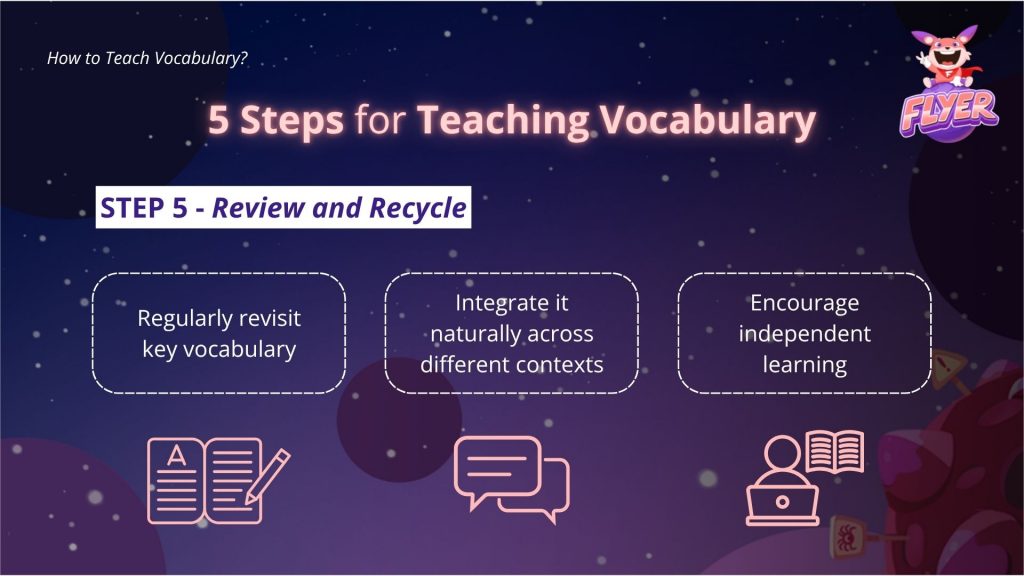
3. Recommended Materials and Tools for Teaching Vocabulary
Finding vocabulary teaching materials and tools online is easy, but finding reliable and suitable ones is not. To save time and improve teaching quality, teachers may find the following trusted resources and tools helpful.
Effective vocabulary teaching resources:
- Cambridge English – Resources for Teachers: Free resources including lesson plans, CEFR-aligned vocabulary lists, sample papers, and speaking practice videos. Especially helpful for teachers preparing students for Cambridge exams (YLE, KET, PET, FCE, CAE).
- Reading Rockets – Teaching Vocabulary: Presents research-based methods such as read-alouds, teacher-led activities, audio listening, real-life word use, and parent involvement.
- Texas LD Center – Five Research-Based Ways to Teach Vocabulary: Recommends 5 evidence-based strategies, including using simple graphic organizers to pre-teach word meanings in about 5 minutes per word.
- Onestopenglish – Vocabulary Teaching Materials: Offers vocabulary teaching resources for adults, with lessons, activities, and supplementary materials suitable for various levels and learning needs.
- Vocabulary in Action Poster – Education Endowment Foundation (EEF): A visual tool summarizing key techniques for direct vocabulary instruction, designed for easy classroom application.
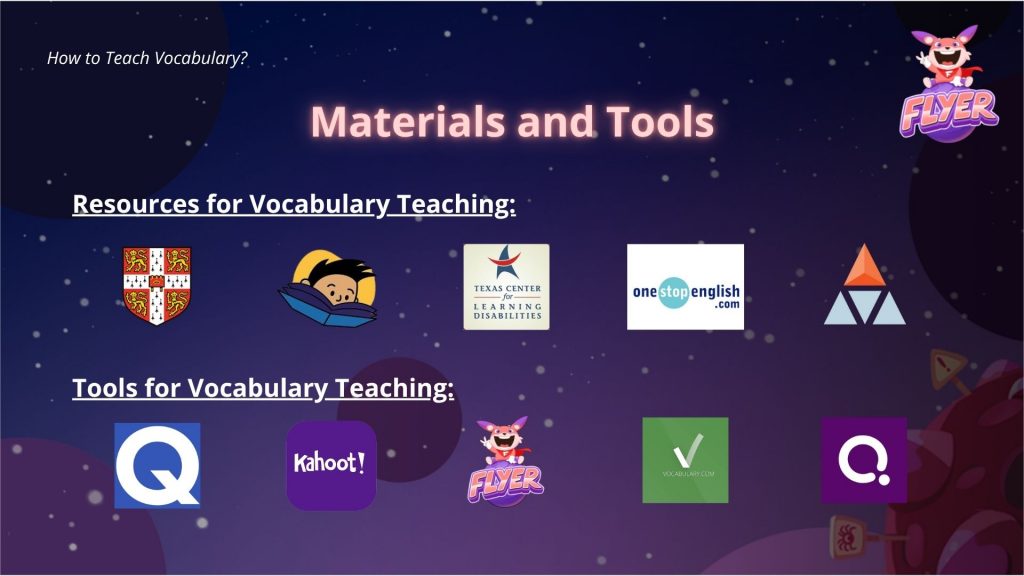
Digital tools to support vocabulary teaching:
- Quizlet: Allows the creation of vocabulary sets with images, audio, and games. The “Quizlet Live” feature encourages collaborative learning.
- Quizizz: An interactive quiz platform with a fun interface, ideal for reviewing vocabulary and conducting quick checks.
- Kahoot!: Enables teachers to create game-based quizzes, making vocabulary practice engaging and competitive.
- Vocabulary.com: Offers vocabulary lists aligned with textbooks and curricula, along with games and exercises to reinforce word learning.
- Flocabulary: Uses hip-hop music and animated videos to teach vocabulary and other subjects, making learning more memorable through rhythm and visuals.
- AI Bingo FLYER: Utilizes AI-powered virtual assistants to engage students in real-time conversations, enhancing vocabulary retention through dynamic and personalized practice.
4. How to Help Learners Memorize New Vocabulary?
To support long-term learning, vocabulary should be stored in long-term memory rather than limited to classroom recall. Here are some effective memory techniques teachers can use to boost vocabulary retention:
- Spaced repetition: Reviewing vocabulary at increasing intervals to transfer words from short-term to long-term memory, using the “spacing effect.”
- Contextual learning: Encountering words in varied contexts – reading, listening, speaking, and writing.
- Mnemonics: Linking new words to familiar concepts or vivid imagery.
- The W.R.A.P Methods – A vocabulary learning strategy that stands for: Write it down – Repeat it – Associate it – Picture it.
- Visual aids: Using pictures or mind maps to create strong visual associations.
- Active recall: Testing memory by recalling or explaining the word rather than re-reading it.
- Elaborative rehearsal: Connecting new words to personal experiences or background knowledge.
- Real-life usage: Applying vocabulary in real contexts such as journaling, conversations, or writing essays.
5. Common Mistakes in Teaching Vocabulary and How to Fix Them
Even when following recommended methods and steps for teaching vocabulary, if common mistakes are not identified and corrected, teaching effectiveness may stagnate or even decline significantly.

Mistake 1 – Overloading students with new words: Makes students overwhelmed.
→ Solution: Focus on teaching 3-5 words per lesson and provide regular opportunities for review and practice.
Mistake 2 – Relying solely on dictionary definitions: Leads to superficial understanding.
→ Solution: Encourage students to use the words in context, create sentences, and engage in discussions to deepen their comprehension.
Mistake 3 – Neglecting active use of vocabulary: Limits vocabulary acquisition.
→ Solution: Give students opportunities to use new vocabulary in speaking and writing activities.
Mistake 4 – Using obscure or uncommon words: Confuses students.
→ Solution: Prioritize high-frequency words that are applicable across various situations.
Mistake 5 – Lack of engagement and motivation: Makes students lose interest.
→ Solution: Incorporate games, songs, and interactive activities to make learning vocabulary enjoyable and engaging.
6. Key Points to Remember When Teaching Vocabulary
Besides common mistakes, what else should teachers consider when applying strategies for teaching vocabulary?
- Ensure learners fully understand the vocabulary and be able to apply it in real situations.
- Teach vocabulary in a logical and natural order. For example, start with everyday words before moving to specialized terms.
- Provide useful vocabulary relevant to learners’ interests.
- Reinforce previously taught vocabulary whenever possible.
- Encourage learners to explore the meanings and real-life use of new words.
- Do not give learners too many words to learn all at once.
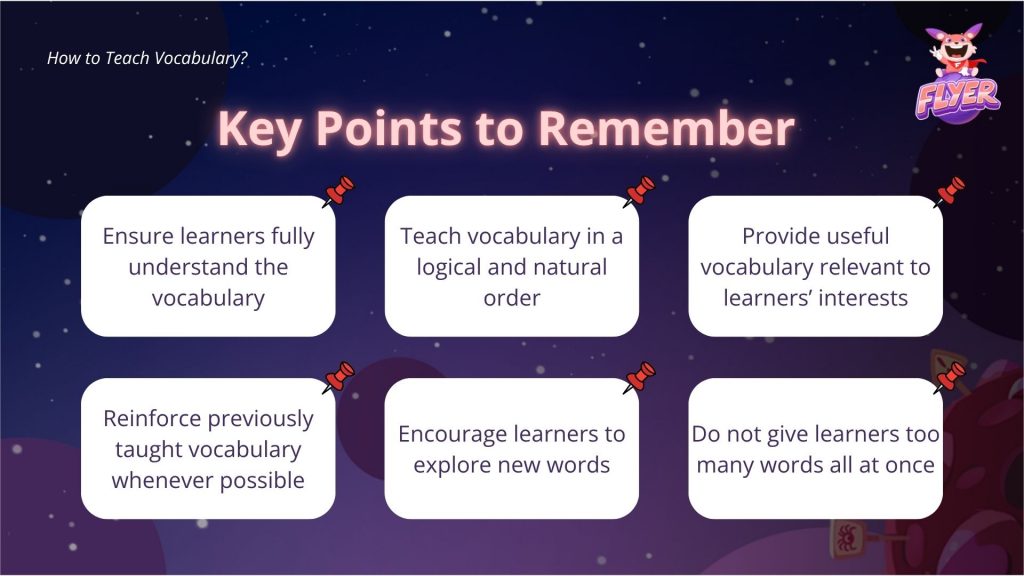
7. FAQs about How to Teach Vocabulary
The best way combines explicit instruction, real-life context, and regular practice. Using visuals, examples, and encouraging student interaction helps build long-term understanding.
Start with high-frequency words, use pictures or gestures, and keep explanations simple. Repetition, games, and real-life examples make learning more engaging and effective.
There are 5 suggested steps to teach explicit vocabulary:
– Select useful vocabulary
– Present the word clearly
– Explain word form and use
– Engage in active practice
– Review and recycle
Focus on academic or subject-specific words. Teach word roots, synonyms, and nuances in meaning. Encourage reading complex texts and using the vocabulary in meaningful tasks.
Tier 1 includes everyday words students usually know. Tier 2 covers general academic words found across subjects. Tier 3 consists of domain-specific terms used in particular fields or lessons.
If you have never heard of the word, let the student know you will look it up and follow up with them. Be sure to follow up.
Conclusion
In conclusion, effective vocabulary teaching revolves around three key principles: contextual, real-life, and practical. With these in mind, teachers can design a variety of engaging and impactful vocabulary activities. Hopefully, the insights shared in this article will be helpful for educators.
You may also like



